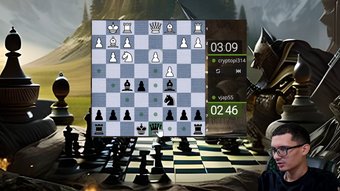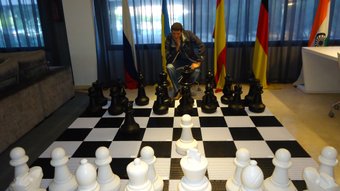El ajedrez y sus aspectos más elementales / Chess from the scratch
About :
.png)
Miniatura de la imagen del video Chess is Life - Chessbrothers
Saludos cordiales amigos de HIVE, especialmente a la comunidad de #fulldeportes.
Una vez más comparto con ustedes contenido de interés relacionado con el Deporte Ciencia, espero que el video que se muestra al principio a modo de introducción sirva para ilustrar y motivar a más personas a que practiquen ajedrez, no solo por simple “capricho” sino porque objetivamente están evidenciados muchos efectos positivos de cara a nuestra salud de los cuales hablé un poco en el articulo anterior.
Ahora bien, una vez que se da el primer paso es necesario entrar en contexto, es decir, el ajedrez obedece a una serie de reglas, normas y principios que deben ser entendidos para poder desempeñar una partida de manera exitosa; por supuesto, muchas personas tendrán objetivos distintos, unos querrán solo aprender lo básico y otros trataran de mejorar los más posible para destronar a Magnus Cralsen lol, por tanto eL enfoque que cada persona debe adquirir variará en función de sus propias proyecciones. Abordar toda la teoría de ajedrez en un articulo es algo que satura demasiado, a fines prácticos es inviable, no obstante con esta publicación espero cubrir algunas de las nociones más básicas y generales de este prestigioso deporte.
Greetings friends of HIVE, especially to the #fulldeportes community.
Once again I share with you interesting content related to Sport Science, I hope that the video shown at the beginning as an introduction serves to illustrate and motivate more people to practice chess, not only for "whim" but because objectively there are many positive effects on our health which I talked a little in the previous article.
Now, once the first step is taken, it is necessary to enter in context, that is, chess follows a series of rules, norms and principles that must be understood in order to play a successful game; of course, many people will have different objectives, some will only want to learn the basics and others will try to improve as much as possible to defeat Magnus Cralsen lol, therefore the approach that each person should acquire will vary depending on their own projections. To cover all the theory of chess in an article is something that saturates too much, for practical purposes is unfeasible, however with this publication I hope to cover some of the most basic and general notions of this prestigious sport.

Imagen propia – la figura del tablero fue realizada con el programa de base de datos “chessbase”
En primera instancia se define al ajedrez como un “juego”, esta concepción obedece a un criterio un tanto simplista, sin embargo, en el desarrollo de este texto veremos como este “juego” obedece a consideraciones más complejas. El ajedrez es jugado entre dos personas, en una contienda que da lugar a un planteamiento estratégico promovido por cada una de las partes inmersas, en el cual cada jugador exhibirá decisiones racionales que buscarán doblegar las ideas de su contrario. Concretamente, el objetivo del ajedrez es “dar jaquemate” al rey de nuestro rival.
El “campo de batalla” donde se desencadena toda la acción lleva el nombre de “tablero”. Éste es un cuadrilátero de dimensiones 8x8, posee 64 casillas en total de las cuales 32 son de color claro y 32 de color oscuro. La imagen clásica de un tablero de ajedrez está representada por los colores blanco y negro, no obstante, con el pasar de los años y la cantidad de estudios realizados, se ha demostrado que el uso de colores más “ligeros” ayuda a evitar la fatiga visual de los jugadores durante el desarrollo de la práctica ajedrecística. Es muy común que en los torneos de alta competencia las casillas oscuras estén definidas por un verde, azul, o marrón de tonalidad clara.
At first, chess it is defined as a "game", this conception is somewhat simplistic, however, in the development of this text we will see how this "game" is based on more complex considerations. Chess is played between two people, in a contest that gives rise to a strategic approach promoted by each of the immersed parties, in which each player will exhibit rational decisions that will seek to subdue the ideas of his opponent. Concretely, the objective of chess is to "checkmate" the king of our opponent.
The "battlefield" where all the action takes place is called "board". This is a quadrilateral of dimensions 8x8, it has 64 squares in total of which 32 are light-colored and 32 are dark-colored. The classic image of a chessboard is represented by the colors black and white, however, with the passing of the years and the number of studies carried out, it has been shown that the use of "lighter" colors helps to avoid visual fatigue of the players during the development of chess practice. It is very common that in high competition tournaments the dark squares are defined by a light green, blue, or brown.

Imagen propia @eniolw vs @vjap55
En concordancia con lo anterior, se definen las “piezas”, estas son las figuras que dan vida al ajedrez. Básicamente, son las herramientas con las que cuenta cada individuo para llevar a cabo todo el desarrollo del juego. Estas se encuentran desplazándose dentro del tablero y obedecen a una forma específica que define su movimiento. Cada bando cuenta con un total de 16 piezas: un (01) rey, una (01) dama (inadecuadamente llamada “reina”), dos (02) torres, dos (02) alfiles, dos (02) caballos y ocho (08) peones.
According to the above, the "pieces" are defined, these are the figures that give life to chess. Basically, they are the tools that each individual has to carry out the development of the game. These pieces move around the board and obey a specific shape that defines their movement. Each side has a total of 16 pieces: one (01) king, one (01) queen (inappropriately called "queen"), two (02) rooks, two (02) bishops, two (02) knights and eight (08) pawns.
El Juego y la Disciplina Deportiva / Chess as a Sport

Imagen propia - @sauko
Definitivamente el ajedrez es un deporte, pese a algunos estereotipos que se han pintado en la sociedad en general. Esta disciplina encierra consigo aspectos fundamentales que lo clasifican como deporte en todos sus niveles. Atendiendo las definiciones que plantea la Real Academia Española (RAE) tenemos que el deporte es:
1. Actividad física, ejercida como juego o competición, cuya práctica supone entrenamiento y sujeción a normas.
1. Recreación, pasatiempo, placer, diversión o ejercicio físico, por lo común al aire libre.
Para quienes practican el ajedrez con relativa seriedad sabrán que todas esas cualidades que se mencionan están presentes en el juego. Si lo comparamos con el fútbol, unos de los deportes más populares (si acaso no el más popular), vemos que la presencia de la estrategia, la táctica son fundamentos claves para desempeñar efectivamente nuestro juego.
Además, debemos considerar ciertas normas o reglas que delimitan al deporte propiamente dicho, para el caso de un atleta (ajedrecista) que lleve una carrera profesional y de alta competencia, deberá estar en constante entrenamiento pues las exigencias de cada partida ameritan una preparación técnica especializada, sin mencionar que para poder rendir eficazmente la persona debe contar con una condición física apropiada. Por tanto, el ajedrez encaja perfectamente con el dicho: “cuerpo sano y mente sana”.
Cabe mencionar que el ajedrez no está incluido dentro de “Juegos Olímpicos”, sin embargo, cuenta con sus propias olimpiadas, siendo estas un evento celebrado fuera de las fechas de las olimpiadas convencionales. Han existido intentos por parte de las Federaciones pertinentes para que este deporte sea incluido en los ciclos olímpicos y esperemos que muy pronto veamos al ajedrez acuñado como “deporte olímpico”.
Chess is definitely a sport, despite some stereotypes that have been painted in society in general. This discipline contains fundamental aspects that classify it as a sport at all levels. According to the definitions provided by the Royal Spanish Academy (RAE), sport is: 1. Physical activity, exercised as a game or competition, the practice of which involves training and submission to rules. Recreation, pastime, pleasure, amusement or physical exercise, usually in the open air.For those who practice chess with relative seriousness will know that all those qualities mentioned are present in the game. If we compare it with soccer, one of the most popular sports (if not the most popular), we see that the presence of strategy and tactics are key fundamentals to effectively play our game.
In addition, we must consider certain standards or rules that delimit the sport itself, for the case of an athlete (chess player) who has a professional career and high competition, must be in constant training because the demands of each game require a specialized technical preparation, not to mention that in order to perform effectively the person must have an appropriate physical condition. Therefore, chess fits perfectly with the saying: "healthy body and healthy mind".
It is worth mentioning that chess is not included in the "Olympic Games", however, it has its own Olympics, being an event held outside the dates of the conventional Olympics. There have been attempts by the relevant Federations for this sport to be included in the Olympic cycles and we hope that very soon we will see chess coined as "Olympic sport".
Notación Algebraica / Notation

Imagen propia- creada usando chessbase
Uno de los aspectos claves y que ha potenciado el desarrollo del ajedrez a lo largo de los años ha sido la “notación” de las partidas que se producen constantemente. Al igual que en otras disciplinas y ramas de la ciencia, como por ejemplo, la física y la química, donde existen registros de experimentos que han sido realizados previamente y cuya recreación de los procedimientos implicados permiten obtener los resultados esperados, bien sea con el fin de visualizar o aprender de algún fenómeno, en ajedrez se cuenta con un sistema de registro de partidas que permite reproducir cada juego en cualquier lugar del mundo con la finalidad de obtener algún aprendizaje a partir de los movimientos de los jugadores.
De lo anteriormente dicho, cabe resaltar que este sistema de registro ha ido evolucionando con el pasar de los años y que el modelo que predomina en la actualidad es el: “sistema de notación algebraica” o simplemente “notación algebraica”. Este modo de anotación se basa en un sistema de coordenadas presente en el tablero. A continuación se procede a detallarlo:
El tablero de ajedrez está compuesto por 64 casillas -como ya se mencionó-. Cada uno de los escaques se representa por una letra y un número, siendo un escaque o casilla la intercepción de una fila y una columna.
Las columnas se identifican con letras (“a”, “b”, “c”, “d”, “e”, “f”, “g”, “h”) y las filas con números (“1”, “2”, “3”, “4”, “5”, “6”, “7”, “8”), por tanto, para referirnos a una casilla ubicamos las fila y la columna que converjan para el caso en que se requiera, por ejemplo, la casilla enmarcada de color rojo la figura 4 se conoce como “e4”.
Para referirnos a una pieza basta con escribir su inicial en mayúscula. Para el caso del rey escribimos “R”, la dama “D”, torre “T”, el alfil “D”, el caballo “C” y para el caso del peón sólo hace falta escribir la casilla hacia donde se desplace. Si queremos llevar nuestro rey a la casilla c5 escribimos Rc5.
En los campeonatos de alta competición es obligatorio anotar la partida de principio a fin (modalidad estándar) y para ello a cada jugador se le facilita una planilla con un formato adecuado que le permite anotar los datos del juego y cada una de las jugadas de la partida.
Muy bien mis estimados lectores, dejaré este post hasta este punto y luego seguimos profundizando en otros aspectos de interes relativos al ajedrez, será hasta una proxima oportunidad, saludos!
Créditos del video - Chess is life - Chessbrothers
One of the key aspects that has enhanced the development of chess over the years has been the "notation" of the games that are constantly produced. As in other disciplines and branches of science, such as physics and chemistry, where there are records of experiments that have been previously performed and whose recreation of the procedures involved allow to obtain the expected results, either in order to visualize or learn from some phenomenon, in chess there is a system for recording games that allows to reproduce each game anywhere in the world in order to obtain some learning from the players' moves.
From the above, it should be noted that this registration system has evolved over the years and that the model that predominates today is the "algebraic notation system" or simply "algebraic notation". This notation mode is based on a coordinate system present on the board. It is described in detail below:The chessboard is composed of 64 squares -as already mentioned-. Each of the squares is represented by a letter and a number, a square being the intercept of a row and a column.
The columns are identified by letters ("a", "b", "c", "d", "e", "f", "g", "h") and the rows by numbers ("1", "2", "3", "4", "5", "6", "7", "8"), therefore, to refer to a square we locate the row and column that converge for the case in which it is required, for example, the square framed in red in figure 4 is known as "e4".
To refer to a piece it is enough to write its initial in capital letters. In the case of the king we write "R", the queen "D", rook "T", bishop "D", knight "C" and in the case of the pawn we only need to write the square to which it moves. If we want to move our king to the square c5 we write Rc5.In high competition championships it is mandatory to write down the game from start to finish (standard mode) and for this purpose each player is provided with a sheet with a suitable format that allows him to write down the data of the game and each of the moves of the game.
Very well my dear readers, I will leave this post until this point and then we will continue deepening in other aspects of interest related to chess, it will be until a next opportunity, greetings!
Video credits - Chess is life - Chessbrothers
Written by @vjap55
Directed by @sawko
Produced by @sawko
Edited by @sawko
Voice @vjap55
Track NEFFEX - Life (Instrumental)
The video was shot by @sawko with Xiaomi redmi note 9 pro and gimbal cineper c11
You can support the project by following us on:
Instagram: @chessbrothers
Facebook: @chessbrotherspro
YouTube: Chess Brothers
Tags :
Their limit for today is $0!
More Videos
@threespeak: 4.1209
@theycallmedan: 3.6159
@stayoutoftherz: 0.5186
@ocd: 0.3202
@alexaivytorres: 0.1433
@fermionico: 0.0540
@roelandp: 0.0413
@fulldeportes: 0.0243
@threespeak: 8.2368
@theycallmedan: 7.2275
@stayoutoftherz: 1.0366
@ocd: 0.6400
@alexaivytorres: 0.2864
@fermionico: 0.1080
@roelandp: 0.0826
@fulldeportes: 0.0486





























Comments:
Reply:
To comment on this video please connect a HIVE account to your profile: Connect HIVE Account